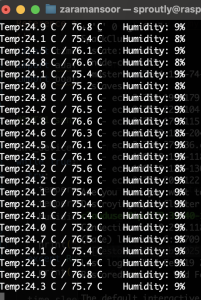This week, I focused on setting up the Raspberry Pi at home and configuring it for our project. I successfully set up a Git repository for the team so we can track our code and collaborate efficiently. I also wrote initial code to collect temperature and humidity sensor data. The temperature readings appeared accurate, but the humidity values seemed off. To investigate further, I plan to rerun tests and, if the issue persists, compare results with backup sensors to determine whether the problem is with the sensor itself or the way the data is being processed. In addition to working on the sensor data, I also started implementing the Plant API data retrieval code, though I haven’t finished it yet. Here is an image of the sensor output data:

As a team, we received most of our components and assembled the greenhouse, ensuring that all parts fit together correctly. We also finished ordering the remaining components, including the plants, so we can begin testing as soon as they arrive with the sensors and start collecting training data for the ML models. My progress is currently on schedule since I have been able to start testing the sensors, though I still need to complete the Plant API integration this week.
Next week, I plan to set up and test the remaining sensors to ensure they are providing accurate readings. I also need to configure the Raspberry Pi to connect to the school’s Wi-Fi so that I can work on it remotely while on campus. Additionally, I aim to complete the integration of the Plant API so we can start using the data in our system.
